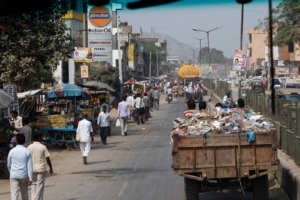How India’s Waste Management System is Causing Health Issues

The first half of 2022 saw India being the second-highest methane emitter in the world. Methane is a powerful greenhouse gas that is almost 84 times more potent in warming the atmosphere than carbon dioxide. According to data that Kayrros SAS analyzed from images that the Sentinel-5P satellite sent, about 78 out of 82 units of methane released in India during the first six months of 2022 were primarily from landfills, livestock, agriculture and sewage. These toxic emissions from open-air landfills are not only adding to the problem of global warming but are also becoming an increasing health hazard for people living near the dumps. These people are mostly from lower-income groups living in the slums, with little to no means to move to another location or change anything about their current situation. The problem does not lie with the landfills per se, but with India’s waste management system.
Deficiencies in India’s Waste Management System
Organic waste that decomposes without the presence of oxygen produces methane. According to Bloomberg, in Indian landfills, about 60% of the waste is organic, such as leftover food, peelings of vegetables, livestock manure, etc. However, the lack of segregation of organic material at the source and the failure to use the waste for composting is a massive setback in solid waste.
India generates “62 million tonnes of municipal solid waste (MSW) annually.” Out of the 43 million tonnes of MSW collected, about 31 million tonnes end up in landfills while only 12 million tonnes undergo treatment. This is an abysmally small percentage.
An important player in the waste segregation process is the informally trained waste or rag pickers coming from the nearby slums. These workers, however, do not receive proper instructions on how to separate the trash into different categories. In fact, they often end up burning the waste in open areas for warmth on cold nights, causing pollution, according to Recycling Magazine. Moreover, these workers do not have adequate gear to protect themselves from hazardous and unsanitary materials, exposing them to skin and blood infections.
According to The New York Times, “a few hundred thousand people earn income” from waste picking in Delhi. The government, therefore, doesn’t restrict the informal recycling sector from operating in fear of political backlash from them.
The lack of publicly available bins, poorly covered garbage trucks and widespread littering by citizens only adds to the problem. According to Recycling Magazine, the government introduced solid waste management rules in 2016, which focused on recovery, reuse and recycling. However, there has been no proper enforcement of the guidelines to date.
Consequences of Improper Waste Management
One of the most infamous dumps is the Ghazipur dump near New Delhi, spanning an area larger than what the Taj Mahal covers. On March 22, 2022, the Ghazipur dump leaked an estimated 2.17 metric tonnes of methane in an hour, according to Bloomberg. Besides causing fires, pollution and landslides, the landfill is also a breeding ground for tuberculosis and dengue.
In an interview with Bloomberg, Owais, a citizen living close to Ghazipur said, “Most of us have health problems. There’s no government health center in our community and many people don’t realize that pollution from the dump is what is causing health problems.”
The Deonar landfill in Mumbai, India is Asia’s largest dumping ground – the size of 268 football fields. Nine thousand metric tonnes of waste ends here daily but the litter neither undergoes segregation nor processing. The stench and smoke from the garbage are the cause of many heart and respiratory diseases in people living in the nearby slums.
According to the Tata Institute of Social Science, there is a high case of malnutrition and tuberculosis among nearby residents. Their life expectancy is around 40, compared to the average urban life expectancy of 73-74. Farha Shaikh, a 19-year-old waste picker in Deonar, stated in an interview with BBC that “Hunger will kill us if not illness.”
The Centre for Science and Environment in Delhi released a study in 2020 which concluded that there are 3,159 garbage dumps in India holding 800 million tonnes of waste. The sizes of these rubbish mountains are only increasing with time with no concrete plans of converting them into sanitary landfills anytime soon.
The Efforts to Improve India’s Waste Management System
In 2019, the government submitted a report that listed recommendations for Solid Waste Management (SWM) in India. Some of the key recommendations were converting landfills into parks, installing more Waste to Compost plants in the country, and formalizing the informal recycling sector. In 2021, the government submitted a report containing the actions taken on those recommendations. One significant progress made by the government was an improvement in the door-to-door collection of garbage and processing the solid waste.
A report that NITI Aayog and the Centre for Science and Environment released in December 2021 highlighted successes in improving India’s waste management system.
Three cities have “adopted a ‘zero-landfill model’ of development,” which focuses on reducing the volume of waste through recovery and recycling, thus eliminating the need for new landfills, The Print reported. One of the cities, Ambikapur, has pulled off 100% collection, segregation, and treatment of waste, while another city in Maharashtra achieved a 100% rate of collecting and processing sanitary waste. Using solar power and radio frequency technology to collect and treat garbage is also proving to be a success in some Indian cities.
Although there have been recent developments and improvements, more source segregation and awareness campaigns could further improve India’s waste management system.
– Anushka Raychaudhuri
Photo: Wikipedia Commons
